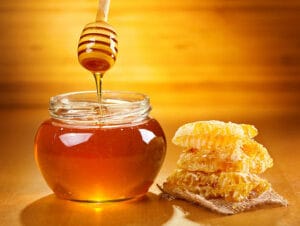- Honey
Honey has many uses, including:

- Antibacterial: Honey contains inhibins, which include hydrogen peroxide, flavonoids, and phenolic acids.
- Honey has been known for its antimicrobial potential, showing a broad spectrum of potential against microorganisms including bacteria. Many important factors contribute to its antimicrobial efficacy, including osmolarity, H2O2content, low pH, phenolic acid levels, and flavonoids. Other phytochemical factors, such as tetracycline, peroxides, amylase, fatty acids, phenols, ascorbic acid, terpenes, benzyl alcohols, and benzoic acid, make honey active against pathogenic bacteria and produce either bacteriostatic or bactericidal efficacy. All of these factors vary according to the nectar source and storage conditions. The emergence of bacterial resistance to honey is very low because of the variations in composition of various kinds of honey due to: 1) nectar source; 2) climatic conditions; 3) duration of storage; and 4) preservation conditions. Synergism was noted when using honey with antibiotics. Such findings will emphasize the potential application of honey with antibiotics and enhance their efficacy and reduce possible emerging MDR.
- Anti-inflammatory: Honey can help reduce muscle inflammation.
- Flavonoids
Honey contains flavonoids, which can inhibit the production of cytokines and chemokines, which are pro-inflammatory signaling molecules. Flavonoids can also modulate gene expression regulators that are pro-inflammatory.
- Low pH and high sugar
Honey’s low pH and high sugar content can create an environment that’s hostile to bacteria, which can reduce the risk of infections that trigger inflammation.
- Antioxidants
Honey’s antioxidant constituents can help mitigate oxidative stress, which is a key driver of inflammation.
One tablespoon, or 20 grams (g) of honey contains
- Calories: 61
- Fat: 0 g
- Protein: 0 g
- Carbs: 17 g
- Fiber: 0 g
- Riboflavin: 1% of the Daily Value (DV)
- Copper: 1% DV
- Honey may offer some protective effects related to blood sugar management, but it should still be consumed in moderation, especially by people with type 2 diabetes.
- Honey may also help prevent heart disease. According to one review, honey may help lower blood pressure, improve blood fat levels, regulate your heartbeat, and prevent the death of healthy cells — all factors that can improve your heart function
- Honey has been linked to beneficial effects on heart health, including reduced blood pressure and blood fat levels.
- Wound healing
Honey can be used as a wound dressing to promote healing. Honey can also help relieve pain in burn patients.
There is a historical precedent for the use of topical honey treatment for wound and burn healing. The practice is still common today.
Manuka honey, specifically, may have positive applications in burn treatments. However, if you have a severe burn, home remedies are not a viable substitute for emergency care, and you should seek medical attention immediately
When applied to the skin, honey can be part of an effective treatment plan for burns, wounds, and many other skin conditions. It’s particularly effective for diabetes-related foot ulcers.
Coughing is a common problem for children with upper respiratory infections. These infections can affect sleep and quality of life for children and parents.
For children over 1 year of age, honey can act as a natural and safe cough suppressant. Some studies show that it’s even more effective than certain cough medicines.

As discussed before, the main benefits of eating honey in moderation may include:
- blood pressure management
- cholesterol management
- wound healing when used topically
- cough suppression
- polyphenol content, which is thought to aid in digestion and have other health benefits
- antioxidant content, which fights free radicals
- Antimicrobial
Honey has antimicrobial properties, which can help reduce the risk of infections that trigger inflammation. Honey can be effective against antibiotic-resistant organisms.
Honey may be a valuable alternative to conventional anti-inflammatory and antimicrobial therapies. However, different honeys may have different variations, so standardized medical-grade honey may be a safer and more optimized treatment.
- In vitro anti-inflammatory properties of honey flavonoids: A review
Highlights . Honey is a flavonoid-rich alternative for traditional anti-inflammatory treatment.